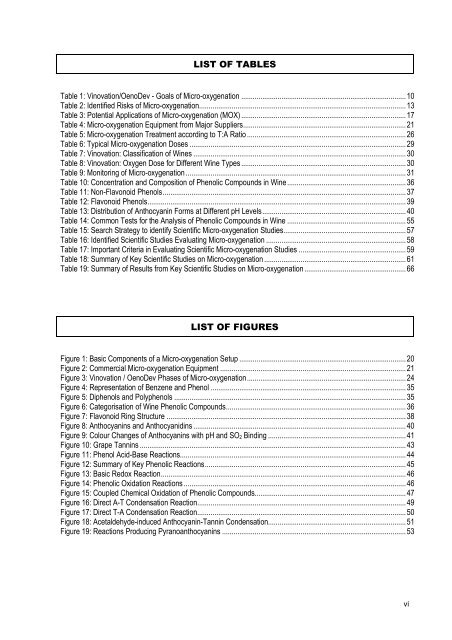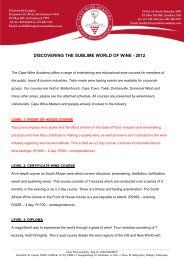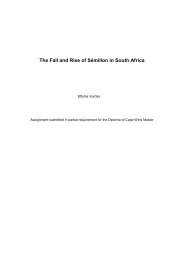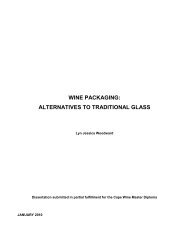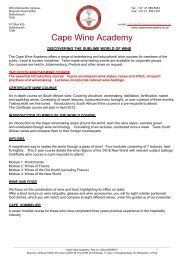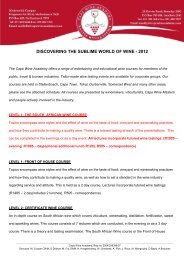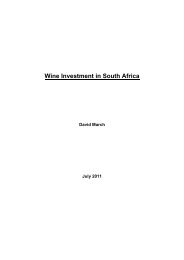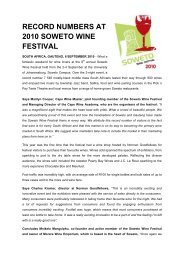micro-oxygenation in contemporary winemaking - Cape Wine ...
micro-oxygenation in contemporary winemaking - Cape Wine ...
micro-oxygenation in contemporary winemaking - Cape Wine ...
You also want an ePaper? Increase the reach of your titles
YUMPU automatically turns print PDFs into web optimized ePapers that Google loves.
LIST OF TABLESTable 1: V<strong>in</strong>ovation/OenoDev - Goals of Micro-<strong>oxygenation</strong> ......................................................................................10Table 2: Identified Risks of Micro-<strong>oxygenation</strong>............................................................................................................13Table 3: Potential Applications of Micro-<strong>oxygenation</strong> (MOX) ......................................................................................17Table 4: Micro-<strong>oxygenation</strong> Equipment from Major Suppliers.....................................................................................21Table 5: Micro-<strong>oxygenation</strong> Treatment accord<strong>in</strong>g to T:A Ratio ...................................................................................26Table 6: Typical Micro-<strong>oxygenation</strong> Doses .................................................................................................................29Table 7: V<strong>in</strong>ovation: Classification of W<strong>in</strong>es ...............................................................................................................30Table 8: V<strong>in</strong>ovation: Oxygen Dose for Different W<strong>in</strong>e Types......................................................................................30Table 9: Monitor<strong>in</strong>g of Micro-<strong>oxygenation</strong> ...................................................................................................................31Table 10: Concentration and Composition of Phenolic Compounds <strong>in</strong> W<strong>in</strong>e..............................................................36Table 11: Non-Flavonoid Phenols...............................................................................................................................37Table 12: Flavonoid Phenols.......................................................................................................................................39Table 13: Distribution of Anthocyan<strong>in</strong> Forms at Different pH Levels...........................................................................40Table 14: Common Tests for the Analysis of Phenolic Compounds <strong>in</strong> W<strong>in</strong>e ..............................................................55Table 15: Search Strategy to identify Scientific Micro-<strong>oxygenation</strong> Studies................................................................57Table 16: Identified Scientific Studies Evaluat<strong>in</strong>g Micro-<strong>oxygenation</strong> .........................................................................58Table 17: Important Criteria <strong>in</strong> Evaluat<strong>in</strong>g Scientific Micro-<strong>oxygenation</strong> Studies ........................................................59Table 18: Summary of Key Scientific Studies on Micro-<strong>oxygenation</strong> ..........................................................................61Table 19: Summary of Results from Key Scientific Studies on Micro-<strong>oxygenation</strong>.....................................................66LIST OF FIGURESFigure 1: Basic Components of a Micro-<strong>oxygenation</strong> Setup .......................................................................................20Figure 2: Commercial Micro-<strong>oxygenation</strong> Equipment .................................................................................................21Figure 3: V<strong>in</strong>ovation / OenoDev Phases of Micro-<strong>oxygenation</strong>...................................................................................24Figure 4: Representation of Benzene and Phenol ......................................................................................................35Figure 5: Diphenols and Polyphenols .........................................................................................................................35Figure 6: Categorisation of W<strong>in</strong>e Phenolic Compounds..............................................................................................36Figure 7: Flavonoid R<strong>in</strong>g Structure .............................................................................................................................38Figure 8: Anthocyan<strong>in</strong>s and Anthocyanid<strong>in</strong>s ...............................................................................................................40Figure 9: Colour Changes of Anthocyan<strong>in</strong>s with pH and SO 2 B<strong>in</strong>d<strong>in</strong>g ........................................................................41Figure 10: Grape Tann<strong>in</strong>s ...........................................................................................................................................43Figure 11: Phenol Acid-Base Reactions......................................................................................................................44Figure 12: Summary of Key Phenolic Reactions.........................................................................................................45Figure 13: Basic Redox Reaction................................................................................................................................46Figure 14: Phenolic Oxidation Reactions ....................................................................................................................46Figure 15: Coupled Chemical Oxidation of Phenolic Compounds...............................................................................47Figure 16: Direct A-T Condensation Reaction.............................................................................................................49Figure 17: Direct T-A Condensation Reaction.............................................................................................................50Figure 18: Acetaldehyde-<strong>in</strong>duced Anthocyan<strong>in</strong>-Tann<strong>in</strong> Condensation........................................................................51Figure 19: Reactions Produc<strong>in</strong>g Pyranoanthocyan<strong>in</strong>s ................................................................................................53vi


